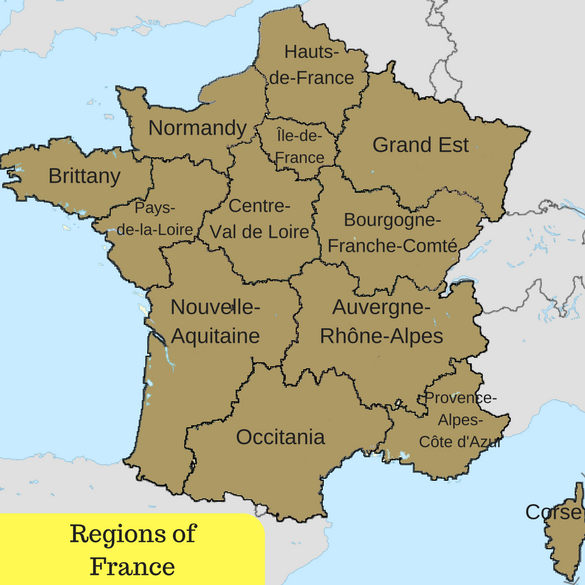Regions of France
I am sure you know how the administrative/local authority areas work where you live but do you know how they work in France? I thought I knew until I looked into it a bit more and realised there were more levels than I knew about.
France Regions
Until last year France was made up of 22 regions but many of these were amalgamated in 2016 to give a total of 13 new regions (+ 5 overseas). Normandy, where we live, used to be in Basse-Normandie (Lower Normandy) but it has now been joined with Haute-Normandie and is now simply called Normandie (Normandy). The full list of regions is as follows:
- Grand Est
- Nouvelle-Aquitaine
- Auvergne-Rhône-Alpes
- Bretagne
- Bourgogne-Franche-Comté
- Centre-Val de Loire
- Corse
- Occitania
- Normandie
- Hauts-de-France
- Île-de-France
- Pays-de-la-Loire
- Provence-Alpes-Côte d'Azur

French Departments
These 13 regions are divided into 96 departments which are local authority areas. Each one has a number according to where they fall in an alphabetical list. Paris is an exception to this with the city divided into several numbers namely 75, 77, 78 and 91-95. Eco-Gites of Lenault is in the department of Calvados which has the number 14. Old French number plates would include their department number. They would be made up of 4 numbers, 2 letters and then the 2 numbers of your department eg 1234 ZX 14 would indicate a car from Calvados. You used to have to change your number plate when you moved to a new department or bought a car from a different department but this requirement has now been scrapped. New number plates are 2 letters, 3 numbers, 2 letters and the department number just shows in the right blue border eg 12 FRT 58 with no need now to change number plates when you move.
French Arrondissments/Cantons/Communes
Departments are divided into 322 arrondissments which themselves are sub divided into 1,995 cantons. Finally the cantons are made up of 36,529 communes with the closest English equivalent being parishes. Each commune has a Mayor (Maire) and is the smallest area of local authority. Our commune of Lénault has recently been combined with 4 other communes to make one larger commune of Condé-en-Normandie .... however true to the French love of bureaucracy and civil servants, each original commune still retains its Mayor so I am not at all sure how things now work at this level! Arrondissments are a way of sub dividing departments and probably best relate the English districts. Cities such as Paris and more recently Lyon and Marseille are also divided into arrondissments. Cantons serve as constituencies with a number of members from them being elected to the assembly (General Council).
Confused? I wouldn't blame you if you were and I have not even mentioned overseas territories, overseas collectives or New Caledonia which are divided in different ways! I think we'll leave those well alone. In fact all you need to remember is that Eco-Gites of Lenault is in the region of Normandy and department No 14, Calvados. And after all those confusing terms why not sit back now and watch a short video of what you can expect to see when you visit Calvados. Enjoy!
Now I have hopefully whetted you appetite for what Calvados has to offer please do come and book a holiday here with us this year. The gite sleeps up to 5 with a 15% discount for couples in low and mid season. We can also give you a discount code for Brittany Ferries. For more details have a look at the other pages on our website and to make a booking enquiry please use this contact form.
Just time then to wish you all a very Happy New Year/Bonne Année and we look forward to meeting you one day soon at Eco-Gites of Lenault.


